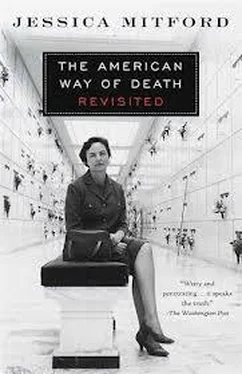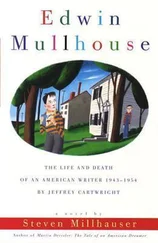There were a few more questions, some about the Federal Trade Commission, some about the anticipated response to the Service Corporation International (SCI) invasion of Britain. In answer to the latter, I tried to explain that I thought it unlikely that the Brits would ever fall for the American way—the idea of people gathering to gaze at a corpse in a coffin wouldn’t catch on. Nor would they embrace the notion of undertakers as grief therapists. The session ended with a short, sharp interchange in which a funeral director refused to tell the assemblage what his exact prices were because, as he explained, he did not wish to divulge this information to his competitors.
Later that day, some of us gathered round the lodge swimming pool for a chat with Tom Fisher. Karen Leonard, my researcher, asked him to elaborate on the point he had made at the meeting about outside forces. “Since you were in the business in 1963, can you talk a bit about the reaction to The American Way of Death ?” she asked.
In his Dakota Tom mode, Mr. Fisher replied: “I said in my speech that I applaud Jessica Mitford. She did us the greatest favor this industry ever experienced. We were flaccid and a little fat around our waist, and I said we were a little smug up here. I said that cleansed us of that. It put us on a diet. The problem was that the funeral directors overreacted so badly, the diet became a starvation diet, and they never found the strength, you know, for almost twenty-five years, to find their way out—how to do something for themselves—so I always applaud her.”
Enclosed in the seminar program was a sheet in which participants were asked to rate the speakers, with a space for comments on each. Avid to hear how I had scored, a few days later I rang up Ron Hast. Enoch Glascock came in first of the seven speakers, he said, but I was No. 2. The comments on my talk ranged from “very complimentary” to “very adverse.” He read out a few examples. Under complimentary: “A true brush with history, a wonderful perspective.” “Delightful, but she appeared to irritate many in the audience.” Adverse: “She’s still a cancer—how easily we forget all the damage she did, making a mockery of funeral service.” “Most unnecessary to provide a platform for a critic of our profession.” There had also been some phone calls, Mr. Hast told me: “One was somebody from Michigan State Funeral Directors Association, a pompous numskull, I couldn’t repeat his language!”
In a subsequent Mortuary Management editorial entitled “Tuning In or Out,” Ron Hast made some of the same points as Tom Fisher had in his poolside chat. He stoutly defended his decision to invite me; as to those who threatened to stop their subscriptions to Mortuary Management , he would “encourage them to call us at our expense to cancel their subscriptions—then go and put their heads back in the sand.”
“We may or may not agree with the beliefs or expressions of Jessica Mitford,” he wrote. “… Statistics now demonstrate throughout North America that simplicity or funeral avoidance is now the tradition in many regions. The American funeral-buying public has changed, and continues to change…. Ms. Mitford asked questions and listened to the answers more than thirty years ago, and produced something the public wanted to hear. Is it not time for us to do the same?…
“Can we expect to receive bouquets and laudatory cheers from Jessica Mitford in her new book? I think not. In fact, it is sensible to anticipate volatile criticism of current practices and agendas targeting death-care providers.”
Reflecting on what I had gleaned from the Tiburon experience, I have concluded that not much has changed over the years in the way undertakers see their world. They would still “vastly prefer” to be looked on as “trained professional men with high standards of ethical conduct,” but the exigencies of their trade still force them into the role of “merchants of a rather grubby order.” Enoch Glascock’s exposition of how to manipulate a family bent on a simple cremation into buying a full-fledged funeral was for me a high point of the seminar—I agreed with the No. 1 rating accorded him by his colleagues. But how does that fit in with Ron Hast’s perception that “simplicity or funeral avoidance is now the tradition in many regions”? Or with the general tone of his and Tom Fisher’s remarks about the impact of The American Way of Death ?
Possibly it was the split personality of the calling, arising out of its inherent contradictions, that led to my invitation in the first place.
2. THE AMERICAN WAY OF DEATH
How long, I would ask, are we to be subjected to the tyranny of custom and undertakers? Truly, it is all vanity and vexation of spirit—a mere mockery of woe, costly to all, far, far beyond its value; and ruinous to many; hateful, and an abomination to all; yet submitted to by all, because none have the moral courage to speak against it and act in defiance of it.
—LORD ESSEX
Odeath, where is thy sting? O grave, where is thy victory? Where, indeed. Many a badly stung survivor, faced with the aftermath of some relative’s funeral, has ruefully concluded that the victory has been won hands down by a funeral establishment—in a disastrously unequal battle.
Much fun has been poked at some of the irrational “status symbols” set out like golden snares to trap the unwary consumer at every turn. Until recently, little has been said about the most irrational and weirdest of the lot, lying in ambush for all of us at the end of the road—the modern American funeral.
If the Dismal Traders (as an eighteenth-century English writer calls them) have traditionally been cast in a comic role in literature, a universally recognized symbol of humor from Shakespeare to Dickens to Evelyn Waugh, they have successfully turned the tables in recent years to perpetrate a huge, macabre, and expensive practical joke on the American public. It is not consciously conceived of as a joke, of course; on the contrary, it is hedged with admirably contrived rationalizations.
Gradually, almost imperceptibly, over the years the funeral men have constructed their own grotesque cloud-cuckoo-land where the trappings of Gracious Living are transformed, as in a nightmare, into the trappings of Gracious Dying. The same familiar Madison Avenue language, with its peculiar adjectival range designed to anesthetize sales resistance to all sorts of products, has seeped into the funeral industry in a new and bizarre guise. The emphasis is on the same desirable qualities that we have been schooled to look for in our daily search for excellence: comfort, durability, beauty, craftsmanship. The attuned ear will recognize, too, the convincing quasi-scientific language, so reassuring even if unintelligible.
So that this too too solid flesh might not melt, we are offered “solid copper—a quality casket which offers superb value to the client seeking long-lasting protection,” or “the Colonial Classic beauty—18 gauge lead coated steel, seamless top, lap-jointed welded body construction.” Some are equipped with foam rubber, some with innerspring mattresses. Batesville offers “beds that lift and tilt.” Not every casket need have a silver lining, for one may choose among a rich assortment of “color-matched shades” in nonabrasive fabrics. Shrouds no longer exist. Instead, you may patronize a grave-wear couturiere who promises “handmade original fashions—styles from the best in life for the last memory-dresses, men’s suits, negligees, accessories.” For the final, perfect grooming: “Nature-Glo—the ultimate in cosmetic embalming.” And where have we heard that phrase “peace-of-mind protection” before? No matter. In funeral advertising, it is applied to the Wilbert Burial Vault, with its ⅜-inch precast asphalt inner liner plus extra-thick, reinforced concrete—all this “guaranteed by Good Housekeeping.” Here again the Cadillac, status symbol par excellence, appears in all its gleaming glory, this time transformed into a sleek funeral hearse. Although lesser vehicles are now used to collect the body and the permits, the Cad is still the conveyance of choice for the Loved One’s last excursion to the grave.
Читать дальше












